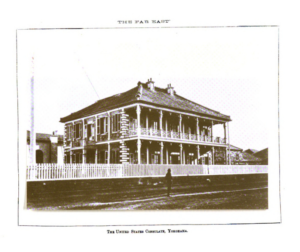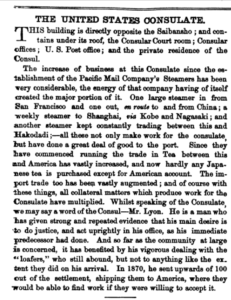

The Ansei Treaties of 1858 ended Japan’s national exclusion through the development of treaty ports such as Yokohama, involving the country in an international trade network dependent on foreign accommodations and concessions. It has been suggested that the treaty ports became a “place of intersection for modern imperialism”. [1] This is evidenced in The Far East publication’s article on the United States Consulate, which demonstrates a conflict between America’s cultural assumptions of its Japanese hosts and the necessity for a productive coexistence.[2]
The article places significance on the location and arrangement of the American Consulate buildings, implying that the physical landscape of the Treaty Ports acted as an authoritative stamp of foreign power, despite the lack of formal territorial possession. It states: “The building is directly opposite the Saibansho” and lists the varying functions of the Consulate itself. The spatial proximity of the buildings creates an impression of American dominance, where the Consulate acted as the capital of success. Indeed, the presence of the Consul’s private residence alongside national corporations, such as the US post office, implies that the infiltration of the US into Yokohama occurred on both a public and private level. Seemingly, traditional boundaries between administrative, commercial and domestic space were largely discarded in favour of the pervasion of a ‘total’ American identity. Social measures such as the importation of American food and the introduction of baseball were important accompaniments to this policy of cultural distinction from the Japanese.[3]
Despite this, the ensuing discussion of commerce in Yokohama presents a conflict between the retention of an American national identity and the necessity for interaction with Japanese industry. The writer’s commending tone toward American commercial success is heightened by the deliberate contrast with Japanese efforts of industrialisation. The writer suggests that the local community comprised of “loafers”, who were better off shipped across to America where they could experience the true meaning of modernity. This implies that American inhabitants of Yokohama subscribed to stereotypes that the Japanese were “essentially feeble” and that foreigners had a “moral imperative” to improve the situation of this isolated outpost.[4] Emphasis of “increased business” as a result of the Pacific Mail Company steamers suggests that the treaty port of Yokohama fostered solely American ambitions which dragged Japan into an international modernity, both physically and psychologically.
This description devalues The Far East’s article as a measured assessment of industrial development in the 19th century. Instead, it suggests that the concept of ‘modernity’ which was fostered during this time was a Western mediated phenomenon, rather than a progression which occurred on Japanese soil. It is true that Japan’s trade increased after foreign intervention- by the end of the twentieth century, Japan and China together supplied one third of the world’s silk.[5] However, in contradiction, there was never one obsolete power in Yokohama. The intersection of West and East created a territorially ambiguous space where both powers met through commercial necessity. Cultural assumptions of Japanese inadequacy still prevailed but were reshaped and overridden by the necessity for interaction. Japan retained autonomy over the division of space in the port, where institutions were “lined up” and jockeying for valuable access to the water.[6] The derogatory description of the local community suggests that American survival depended on interactions with local Japanese as physical isolation was both impossible and detrimental. Imports from the West have been described as “the first step toward prosperity” for new Meiji Imperialism. The state propagated an image of aspirational Japan who acted as a facilitator of international trade, inserting themselves into the narrative of modernity which the Far East implies was exclusively ‘Western’.[7] Consequently, whilst the American presence was notable in Yokohama, it did not exist without interdependence on the locals, which stimulated a search for national identity on both parts. This made the treaty ports a unique setting, where national identities were forged and redefined in an environment of divergence.
Bibliography
Primary Source
Anglin, James, “The United States Consulate”, The Far East, Vol.1, No.18, (Yokohama February 1871), pp.5-6.
Secondary Sources
Ambaras, David, Japan’s Imperial Underworlds: Intimate Encounters at the Borders of Empire, (Cambridge 2018).
Bytheway, J, “The Arrival of the Modern West in Yokohama: Images of the Japanese Experience 1859-1899”, in Donna Brunero and Stephanie Villalta Puig, Life in Treaty Port China and Japan, (Singapore 2018), pp.246-267.
Hoare, James, The Japanese Treaty Ports 1868-1899: A Study of the Foreign Settlements, (London 1970).
Roden, Donald, “Baseball and the Quest for National Dignity in Meiji Japan.” The American Historical Review, vol. 85, no. 3, (Oxford 1980), pp. 511–534.
Taylor, Jeremy, “The Bund: Littoral Space of Empire in the Treaty Ports of East Asia”, Social History, Vol. 27, No.2, (2002), pp. 125-142.
Xu, Yingnan, “Industrialization and the Chinese Hand-Reeled Silk Industry (1880-1930)”, Penn History Review, Vol. 19, No.1, (Pennsylvania 2012), pp.27-46.
[1] David Ambaras, Japan’s Imperial Underworlds: Intimate Encounters at the Borders of Empire, (Cambridge 2018), p.71.
[2] James Anglin, “The United States Consulate”, The Far East, Vol.1, No.18, (Yokohama February 1871), pp.5-6.
[3] James Hoare, The Japanese Treaty Ports 1868-1899: A Study of the Foreign Settlements, (London 1970), p.111. Donald Roden, “Baseball and the Quest for National Dignity in Meiji Japan”, The American Historical Review, vol. 85, no. 3, (Oxford 1980), p.512.
[4] Roden, “Baseball and the Quest for National Dignity”, p.152.
[5] Yingnan Xu, “Industrialization and the Chinese Hand-Reeled Silk Industry (1880-1930)”, Penn History Review, Vol. 19, No.1, (Pennsylvania 2012), p.31.
[6] Jeremy Taylor, “The Bund: Littoral Space of Empire in the Treaty Ports of East Asia”, Social History, Vol. 27, No.2, (2002), p.134.
[7] J. Bytheway, “The Arrival of the Modern West in Yokohama: Images of the Japanese Experience 1859-1899”, in Donna Brunero and Stephanie Villalta Puig, Life in Treaty Port China and Japan, (Singapore 2018), p.256.